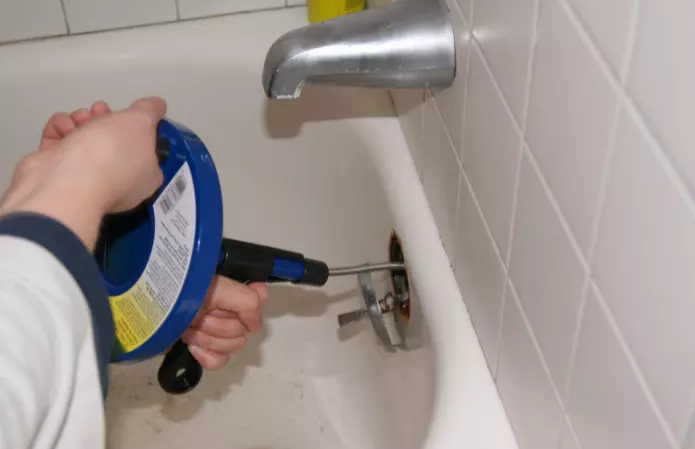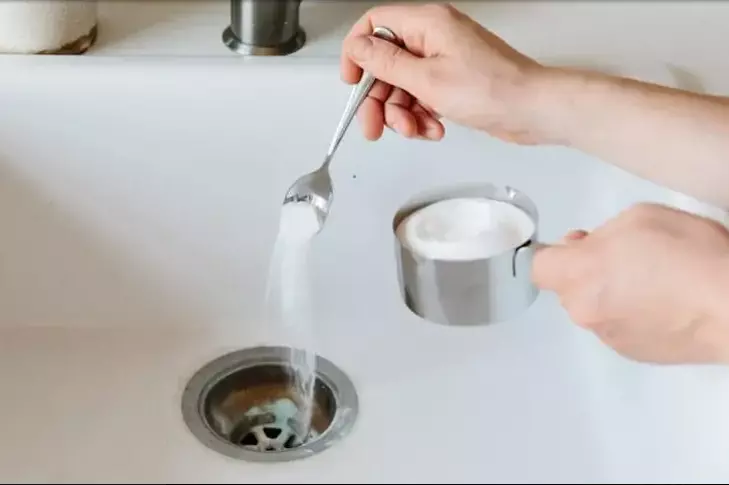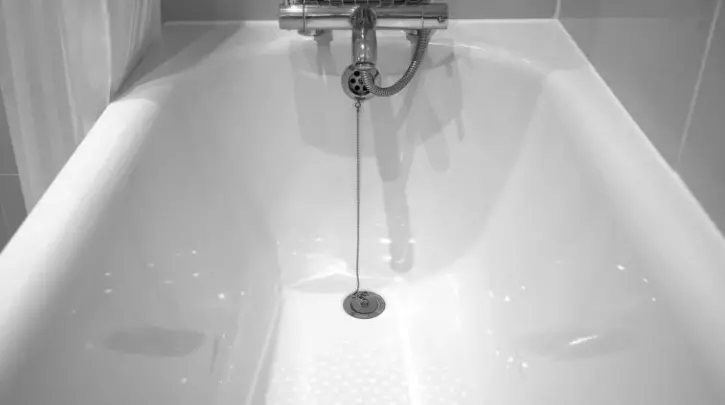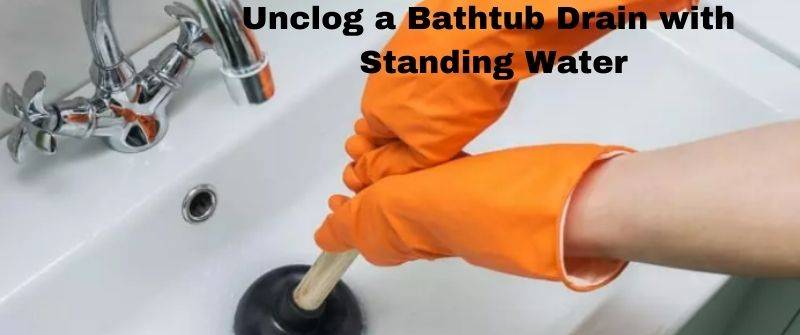If you have a bathtub drain with standing water, it can be a real pain. There are many ways to unclog a bathtub drain with standing water. The best way depends on what kind of bathtub you have. For instance, if you have a pop-up drain, the most common kind of bathtub drain, then several good techniques are easy to do yourself.
Having a clogged bathtub drain is not a pleasant situation. A clog in your bathtub drain can make you feel stuck in place. However, by following the steps below, you will get rid of this problem rather quickly. Here is a guide on how to deal with water sitting in the tub drain.
What Clogs a Bathtub?
One of the most common causes of a clogged bathtub is the build-up from soap scum, hair, and other items stuck in the drain. Another common cause is a foreign object falling down the drain and blocking it up. It is crucial to know how to unclog a bathtub drain properly when this happens.
How to Unclog a Bathtub Drain with Standing Water
If you have water sitting in the tub drain, most likely, you have a clogged bathtub drain. The first thing to do is remove the cover of the overflow drain. This will allow any water that gets past the clog to drain down through the overflow pipe and not spill over onto the floor. The following steps to use to overcome the challenge:
1. Remove All Visible Blockage
Wear gloves to protect your hands from bacteria and germs, and use your fingers to remove any visible hair or other debris. It is an excellent method of how to unclog sink or bathtub drain full of hair effortlessly.
2. Use a Plunger
A good old-fashioned plunger is one of the most effective ways to unclog a clogged bathtub drain. If the water in your tub is not draining at all, you may need to use an auger. A plunger will work best if there is some water in the tub so that there is enough pressure to force the water through the drain.
To keep the plunger from falling over and losing suction, run a little bit of water into the sink or toilet next to where you are plunging, so it overflows onto the floor. This will prevent a vacuum from forming between the two drains.
3. Use a Drain Snake
Professional plumbers also use this tool to unclog drains as a plumbing snake, an auger, or an electric eel. It has a long flexible cable that you feed down into your drain until it reaches the obstruction, and then you crank it so that it can break up whatever is blocking the pipes and allow your water to drain freely again.

Plumbing snakes are long, flexible augers that you can feed into the pipe to break through and pull out the clog.
If you do not already have one, many hardware stores and home centers rent them for a small fee.
Rent a plumbing snake from your local hardware or home center store.
Use an auger with a cable long enough to reach the farthest point of the bathtub drain (usually about 15 feet). You will also need a bucket, rags or paper towels, rubber gloves, safety glasses, and old clothes.
Remove the overflow plate at the top of the tub by loosening its two screws with a screwdriver or Allen wrench (depending on which type of fasteners it has). Place towels around the base of the tub to soak up any water that spills when you remove the stopper and drain assembly.
4. Use Baking Soda and White Vinegar
If you have a bathtub clogged with standing water, there is a good chance that the build-up of hair and soap scum is to blame. Luckily, this is also one of the most manageable clogs to clear using natural products.

To start:
- Mix equal parts baking soda and white vinegar in a small bowl.
- Once you have created your mixture, pour it down the drain.
- After pouring the mixture down the drain, plug the drain with a rag or stopper and allow it to sit for 30 minutes to an hour.
Next, run hot water down the drain for five minutes. If your bathtub is still clogged, repeat the process until it runs freely again. This is a practical approach how to unclog bathtub drain without removing the stopper.
5. Use Chemicals down the Drain
If you have standing water in the tub after draino, try pouring a chemical drain cleaner down the pipes. You can find various cleaners at your local hardware store, but it is best to avoid harsh cleansers like lye or acid-based products.
These especially caustic chemicals can damage your pipes and make your clog worse. Instead, opt for more natural cleaners made from baking soda, lemon juice, or vinegar.
To use this method, follow the instructions on the bottle. The package should tell you how much to pour down the drain and how long you should wait for it to work. Most natural cleaners need about 10 minutes to do their job before you flush them out with hot water.
What to Do if Your Bathtub Won’t Drain Yet it is not Clogged
If you have standing water in tub after drano, yet it is not clogged, chances are the stopper mechanism is broken. There are several types of bathtub stopper mechanisms, and how you remove yours will depend on what type of tub you have. Fortunately, this problem is easy to fix with elbow grease and a few simple tools.
1. Check the Overflow Cover
If you have never had to deal with a clogged bathtub, you may not realize a connection between the overflow drain and your main bathtub drain. This means if something clogs one, it can cause problems for the other.
This is why you should check the overflow cover first. You will find this at the very top of your tub. If you can see water coming out of it, you know there is a blockage somewhere down the line.
2. Push the Clog Through
A plunger may not work because the suction force may not be strong enough to push through what is blocking your tub drain. To take care of this problem, you will need to use a plumber’s snake or auger. You insert this into your tub drain and push it in as far as you can go.
3. Inspect the Tub stopper
If you have a trip lever or lift-and-turn stopper, open and close it several times to make sure it’s not corroded and will operate properly. Clean any debris from the stopper mechanism with a bottle brush or toothpick.
4. Check the Vent
If your bathroom sink is not draining y, you may have a problem with the vent located on your roof. Sometimes debris can get stuck inside of vents and prevent air from flowing through them properly. This can force water to flow back down your pipes instead of exiting the home through your roof vent.
Tips How to Prevent Bathtub from Clogging
1. Use Strainer
The most common way to keep your bathtub from getting clogged is by using a strainer in your tub drain.

You can purchase this at any hardware store.
Make sure that you choose one that has holes in its mesh to catch hair follicles and other dirt such as soap scum and shampoo residue.
You will only need to put the strainer on top of your tub drain and let it do its job by catching all the dirt before they reach the drainpipe, leading to blockage.
You should clean it regularly or whenever you notice that it is filled with dirt to be sure that it is working effectively.
2. Clean the Hair
If you want to prevent the bathtub from clogging, you need to prevent hair from going down the drain. When you take a bath in the tub, use a strainer on the drain to catch all of the hair that comes out of your body.
Put the strainer in the plug hole and leave it there when you are not using it so that it is always ready when you need it.
3. Use Liquid Soap
Use liquid soap instead of bar soap if possible to keep your bathtub from clogging. Bar soaps contain fats and oils that stay in the pipes even after they have washed down the pipe.
These fats and oils can build up over time and create a thick layer in the pipes. The thickness might cause the water to slow or stop altogether, leading to a clog.
4. Clean Regularly
It is a good idea to clean the drain strainer, and pop-up stoppers routinely. You can remove the strainer and use a toothbrush to scrub away any debris that may be stuck on it.
To clean a pop-up stopper, unscrew the pivot rod, which will allow you to pull it out (if you can’t figure out how to do this, check your manufacturer’s instructions for your specific model). Once removed, clean the pivot rod with a toothbrush and flush it out with water.

As a homeowner, I am specifically keen on home improvement. I am passionate about homes, yards, and home improvement. I blog on home ideas and reviews on solutions that make homes better.

